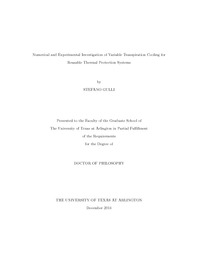| dc.description.abstract | This research work is focused on the numerical and experimental investigation of the transpiration cooling technique for reusable thermal protection systems. The transpiration cooling has been considered because of its higher cooling effectiveness, with respect to other active cooling techniques, in terms of minimum amount of coolant to be used and minimum interference to the external flow. An innovative approach based on the coupling of the hypersonic boundary layer with the thermal response of porous materials is used to numerically study the thermal management potential of the transpiration cooling technique. The new concept of the variable transpiration is introduced by imposing selected distributions of the coolant transversal velocity at the wall. It allows defining the most promising injection strategies in terms of wall heat flux reduction and coolant-mass saving. Parametric analyses with respect to different combinations of transpiration strategies and properties of the porous material (porosity, permeability, thermal conductivity etc.) allowed defining the main properties of the prototype axisymmetric porous nose to be used for the experimental campaign on transpiration cooling that is in preparation at the University of Texas at Arlington (UTA). The experimental non-intrusive characterization of the aforementioned carboncarbon (C-C) porous structure has also been performed in order to define the blowing properties of the thermal protection system (TPS) prior to the experimental campaign on transpiration cooling in the 1.6 MW arc-heated wind tunnel (AHWT) at UTA. A new methodology is introduced for the calculation of the local effective permeability by using hot-film anemometry coupled to the 3-D computed tomography of the specimen. The asymmetric blowing capability of the cone highlights the importance of characterizing the entire thermal protection system instead of defining the overall properties of the material, which can be drastically different at the full-scale level due to the geometry, the system integration (e.g. boundary constraint on the structure) and the intrinsic defectology coming from the manufacturing process. The experimental characterization of the high-enthalpy flow downstream the nozzle exit of the AHWT has been carried out by using ablative Teflon R probes in combination with total pressure measurements with the purpose of augmenting the current capabilities for the investigation and qualification of candidate TPS materials. The results obtained in this investigation show the possibility of using inexpensive and rapidly machinable Teflon R probes for the flow characterization of arc-heated wind tunnel facilities by having uncertainties comparable to those characteristics of standard metal heat flux probes and with the added capability of detecting flow non-uniformities by inspection of the ablation pattern on the surface. | en_US |

